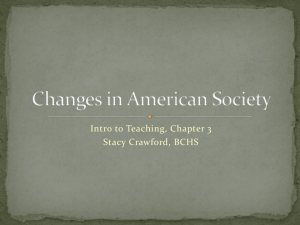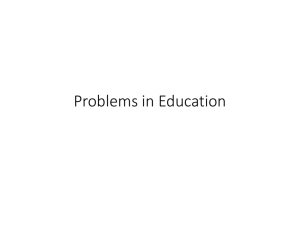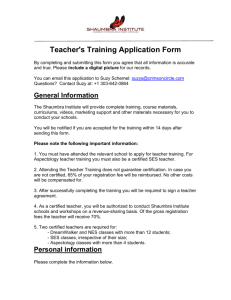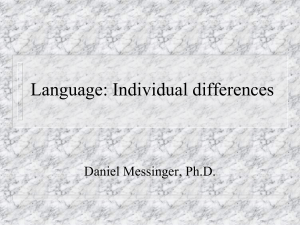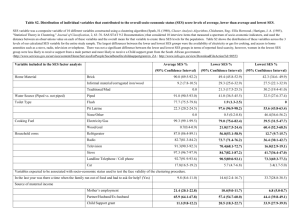Advanced Developmental Psychology
advertisement
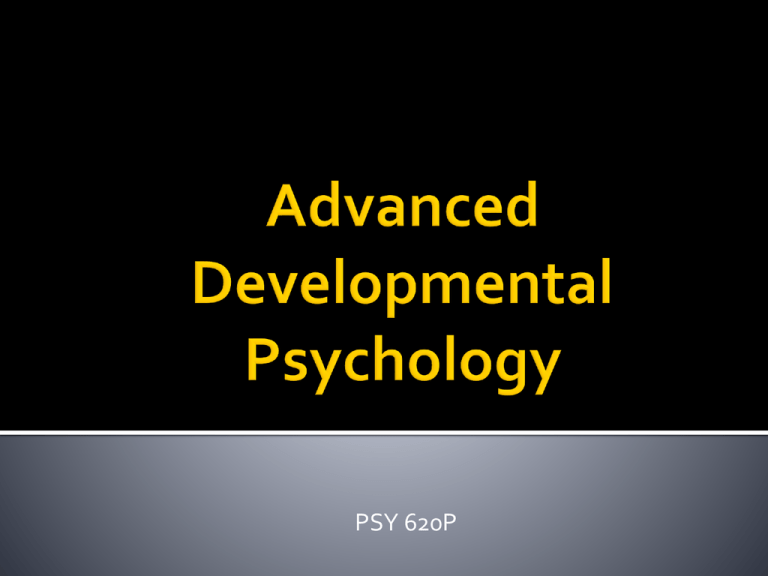
PSY 620P Perception Cognition Language Social/Emotional At birth, infants are capable of discriminating all phonetically relevant differences in the world’s languages They perceptually partition the acoustic space underlying phonetic distinctions in a universal way. By 6 months of age, infants raised in different linguistic environments show an effect of language experience. Their representations are becoming language specific 3 English-learning infants hear Hindi contrast better than English-speaking adults Almost as well as adult Hindi-speakers 100 90 80 70 60 50 40 30 20 10 0 Hindi Adults Infants English Adults Dentral vs. retroflex "t" 4 Infants lose this ability in the first year of life, especially toward one year of 6-8 Monthsage 100 90 80 70 60 50 40 30 20 10 0 8-10 Months 10-12 Months Dentral vs. retroflex "t" 5 To a Hindi speaker, the difference between the “d” sounds in “this doll” versus “your doll”—a phonetic contrast between a dental [d̪al] versus a retroflex [ɖal], respectively— would signal two possible word forms (either lentils or branch). In English, both of those “d” sounds signal just one possible word form—phonetically labeled as an alveolar [dal]. 6 8 Development involves relatively permanent change, but not always improvement in all things. 9 2008 • By 8 months, infants categorize speech into phonemes congruent with native language Recent studies of mother-infant interactions found little mimicry by prelinguistic infants MOST matching is from parents imitating infants… • Alternate mechanism of language development: caregivers consistently respond to babbling and cause changes in patterns of vocalizations (contingent reinforcement) General: 60 infants, 9.5-month-olds and caregivers, playroom Instructions to parents through headphones Second session with three parts (baseline 1, social response, baseline 2) each ten minutes long Conditions (4): looking at types of vocal learning AND contingent reinforcement Contingent response with fully resonant vowels (contingent-resonant) Contingent response with words to introduce consonant-vowel combinations (contingent-CV group) Yoked control conditions for each- matched with a contingent dyad Coding: Types of vocalizations, frequency of vocalizations, 21 1. Do children exhibit word class bias in their first 10 words? 2. How variable are these words across languages? 970 children learning: American English Mandarin Chinese Cantonese Chinese Distribution of Children’s Home Location 369 265 336 United States Beijing Hong Kong Children were sampled from the US, Hong Kong, and Beijing Children were screened for a number of medical exclusion criteria Parents of the children were native speakers of their particular language 6 of the top 20 words appeared in all three languages Almost all categories had strong similarities in words that appeared Children first learned nouns that were manipulable objects that they frequently encountered Children across cultures consistently produced people terms Prevalence of object and animal words varied across cultures Most words children produced fell into people and sounds/ sound effect categories Fewest words in adjectives and closed class categories Children from the US Children from Beijing Children from Hong Kong There are differences in language development across SES Environment plays a role in language development Mothers are primary source of language experience Is the effect of environment global or is there evidence for environmental specificity? Explain the relationship between SES and language development through environmental specificity Identify underlying mechanism of this relationship Hypotheses Differences in children’s SES-related language-learning experiences can explain SES differences in vocabulary development Maternal speech mediates the relationship between SES and vocabulary development Participants (N=63) Children ages 16-31 months 33 High-SES families College educated Employed in professional or managerial positions 30 Mid-SES families High School education Employed in unskilled, semiskilled, or service position Moms not employed outside the home more than 15 hr/week Measures Maternal Speech - linguistic and social properties Child Vocabulary - # of word types in 90-utterance speech sample Mediation Model SES Child Vocabulary SES Maternal Speech Maternal Speech Child Vocabulary Strength of relationship between SES and Child Vocabulary reduced Correlations and Multiple Regression Alert There are 2 components to this relationship 1. SES affects maternal speech Childrearing beliefs Time availability 2.Maternal speech affects language growth Provides data for child’s word-learning mechanisms Longer utterance -> more variance in word types (richer vocabulary) Longer utterance -> more info about meaning Longer utterance -> richer syntax Relationship between SES and language development influenced by language experiences Evidence for environmental specificity Enriching language experience can increase vocabulary development for lower SES children How would the relationship change if the researchers included low SES mothers and children? Should SES be used as a continuous variable? What other mother-child interactions could have been examined? Researchers looked at 2 time points, 10 weeks apart, is that enough time? How might the study’s findings help explain SES-related differences in IQ? Alert Meaningful differences in the everyday experiences of young American children. Hart & Risley (1995). Baltimore, MD: Brookes Publishing Co 43 44 “Parenting” = Language diversity + feedback tone + symbolic emphasis + guidance style + responsiveness Predicts between and within SES groups 45 46 ‘To intervene with vocabulary growth rate … increase the experiences available to the children Limited success … ultimately the growth rates increased only temporarily. Could easily increase the size of the children’s vocabularies, could not accelerate the developmental trajectory.’ “Removing barriers and offering opportunities and incentives is not enough to overcome the past, the transmission across generations of a culture of poverty.” 47 Vocabulary development depends on specific properties of language experience Implies that enriching language experience can increase vocabulary development for low-SES kids 90% of children with sensory neural hearing losses born to hearing parents Important Factors: Maternal sensitivity SES Age of cochlear implantation Duration of auditory deprivation Parental linguistic input ▪ Quantitative (Word types, Mean length of utterance) ▪ Qualitative (Facilitative language techniques [FLTs]) 93 children 2 years of age and younger at preimplantation Baseline: 2-4 weeks prior to cochlear implantation surgery, with return visit 4-6 weeks later for implantation activation Assessments at 6 months, 12 months, 24 months, and 36 months (6 month assessment not included in data) Measures: demographics, Reynell Developmental Language scales, Videotaped interactions (one structured, one unstructured) Cruz, et al., 2013 Vernon-Feagans et al. (2012)

